Fanmode interview: Bryan Wilkinson (part 3)
Long-time Micronauts and Microman fan, Bryan “MicroBry” Wilkinson, is one of the select few who’ve made the transition from toy fan to toy designer. His website was one of the earliest to draw attention to Transformers’ (then) little-known origins, and he was given the opportunity to work on Palisades’ Micronauts revival in 2002. As Transformers celebrates its 25th. anniversary and Microman celebrates its 35th., we thought it only appropriate to ask him about Micronauts, Microman, Transformers, fandom, and making the transition from consumer to creator.
(Due to its length, the interview will be presented in several parts. Parts one and two were published earlier.)
How did you get involved with the Palisades Micronauts line?
Palisades originally picked up the Micronauts license partly because the person representing Abrams Gentile Entertainment (the rights holders then) at an industry event had implied that they had access to the original molds and tooling. Palisades believed that they’d be able to bring back any toys from the full series without having to worry about new sculpts and the like. This turned out not to be the case, and after looking at the breadth and complexity of the original toys, they had to scale back the project as everything needed to be built from scratch.
(Takara mysteriously had no involvement in the development at all, and stories differ from all sides on that matter. It’s a shame because a collaboration could obviously have proven mutually beneficial.)
When Ken Lilly, head of Palisades’ product development then, put out the word on one of the toy forums that he was looking for vintage samples for the line, I helped put him in touch with interested collectors willing to help out. Many in the community wanted to see this work and do what they personally could to help make the dream of bringing the Micronauts back a reality. As I was co-moderator of the Micropolis Embassy Yahoo! Group, I helped as a sort of liaison and then as a general fan consultant for the project. The group’s owner and main moderator, Ray Miller, also became heavily involved and gave a lot of additional quality control suggestions and feedback on the pre-production samples, and InnerSpace Online‘s Dave Waugh happened to live near Palisades and contributed a huge deal.
How did you get involved in the design process?
I didn’t really know it at the time, but Palisades and Ken had a history of bringing designers on board from the fan community of each property they licensed.
When Ken was working on ideas for accessories for the second series of toys, I made a few suggestions and backed it up with some quick pre-visualisation concept renders I whipped up on the spot. (As luck would have it, I’d just been finishing some 3D modeling training at a local 3D animation school, and I’d done some prior amateur stuff with Japanese Microman fan group MicroGeneration.) While the stuff was pretty crude, it got the idea across, and Ken asked me if I’d like to do more, in fact design almost all the accessories for the line that hadn’t been done yet.
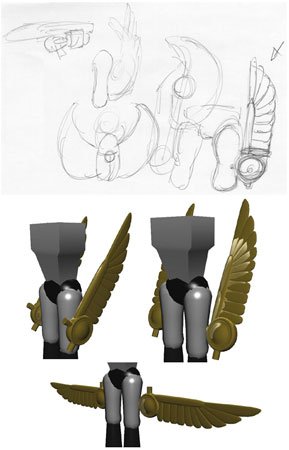
Copyright © Bryan Wilkinson. Used with permission.
Micronauts copyright © 2002 AGE, Takara, licensed to Palisades Toys.
So, I did the accessories, got a lot of direction and feedback from Ken and he was really happy with the work. Then he asked if I could do whole figures. I sent him one of Centaurus I had been working on. He explained he’d like to have some pre-visualisation renders done of each of the figures so we could do color models for each one to give to the factory and was willing to commission them. So from there I did color models for all the figures in the line along with some additional CG art for the packaging on the exclusive Series 1.5 figures and a few additional designs, such as the Time Medic.
I also designed an unused accessory for Red Falcon that would have turned its extra parts into a vehicle the 3¾” figures could ride. It got nixed as it would have required a 3-part mold, which is a shame because if I’d known a little more about the process at the time, I’m sure I could have redesigned it for a 2-part one.
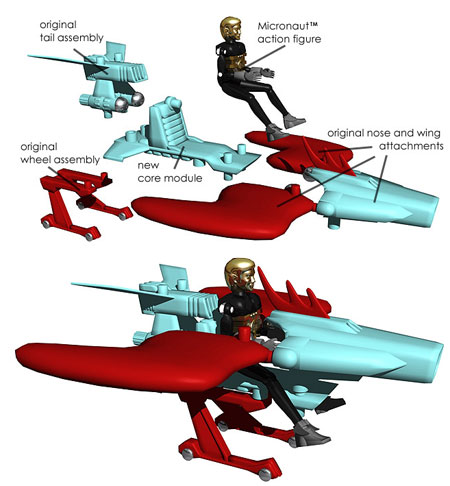
Copyright © Bryan Wilkinson. Used with permission.
Micronauts copyright © 2002 AGE, Takara, licensed to Palisades Toys.
Along the way, I helped put together our team of fan consultants for brainstorming original ideas for a Series 3 of all-original figures. It was a real thrill to see what exciting ideas others in the community had in mind for the project.
What other projects did you work on for Palisades?
I worked again with Palisades on the Invader Zim line in early 2004. As a fan of the show, it was a real privilege to work on the project, which was probably the most successful of the ones I worked on. One of my friends, Cassandra Poe, who was something of an authority on the series, provided invaluable guidance, incredible esoteric knowledge about the series, and provided an insane amount of reference material at a time the DVDs of the series were not released yet. The toyline wouldn’t have been half as cool or as deeply referential without her input and support.
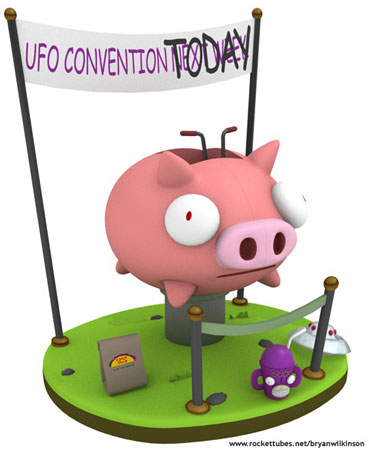
Copyright © Bryan Wilkinson. Used with permission.
Invader Zim and Nickelodeon © 2004 Viacom International Inc. All Rights Reserved.
Micronauts was the perfect influence for creating new playsets and accessories, for Invader Zim’s cartoony sci-fi styling is not far removed from the retro-sci-fi feel of the 1970’s Micros. Ken Lilly and I both wanted to incorporate 5mm parts in as much as we could for interchangeable components in the toys, so he relied on me to take his general rough ideas and translate them into workable toy concepts that were in the style of the show. I had wanted to make the 5mm parts more cybernetic-feeling if we had done new, original Micronaut toys, so I was able to take that and expand upon it and exaggerate it a little for the Zim toys.
I also did accessories for the Adult Swim toys in August 2004. The designs were all over the board in style, ranging from cartoony to more realistic, depending on the show. A little secret about the Broodwich: the design’s little bat wings were very similiar in structure to the ones on the Micronauts Repto, so I was able to take his wings and reshape and tweak them to match the character design. And thanks to Harvey Birdman’s set, I got to have the dubious distinction of creating one of the few action figure urinals ever made!
I did the figures for Die Hard PALz (Palisades’ own block figure series) in October 2004 which was exciting and challenging. I’d never done caricature work before, and here I was making cartoon versions of Bruce Willis, Alan Rickman, and others. It was the only Palisades line that I did original work on the main figures themselves as well as the accessories and playsets.
I was commissioned to do a statue of the Quintesson for Palisades’ licensed Transformers statue line. I mixed the original model sheet line art from Floro Dery and some of the Dreamwave comic redesigns with a Takara SF Land look borrowing from a lot of the modeling techniques I used working on the Micronauts. It never saw production because the line was cancelled when Palisades went under.
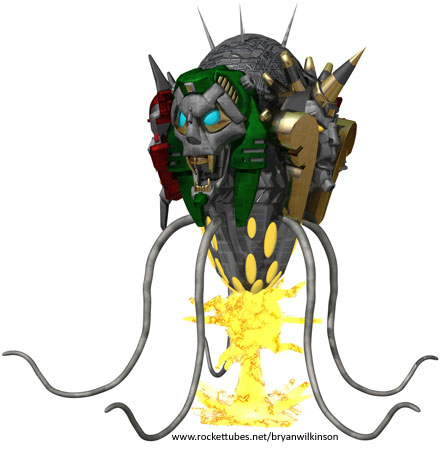
Copyright © Bryan Wilkinson. Used with permission.
Transformers and the Quintesson are trademarks of and/or copyright © Hasbro.
What surprised you about the toy design process?
You have to be really careful about what you give the factory, because if there are any errors or things that are uncertain, chances are they will become glaringly apparent along the way. Some things you think are obvious are not so when looked through the eyes of someone unfamiliar with what the part is or is supposed to do. Pharoid‘s gun is the one that stands out the most for me as the grip and wrist clamp came out way too big, and wasn’t corrected in time. In retrospect, we should have included a comparison with Galactic Defender‘s gun since I used the same parts for both in my models.
There was something very, very surreal about the whole process. The sculpts and castings nearly always did a great job replicating my renders. The fact I had worked with them so much in virtual form combined with the long delay between creation and the final product meant by the time I actually held them in my hand they no longer felt like something I had made, but rather like something that had been around all along that I’d already previously handled!
What was it like to work on a property you had such a strong connection to?
Incredibly exciting, stressful, and fun.
I’d always dreamed of being able to work on making Micronauts or similar toys or characters someday, but as a computer software person, I never thought it would ever be any more than a dream.
I felt a lot of pressure to stay as true as possible to the original vision of the series yet contribute something new. I knew it would have to pass the scrutiny of other fans, let alone satisfy my own standards as a hardcore fan. I put huge amounts of time into getting the figures right, which was a tremendous learning experience.
Doing this gave me a new appreciation of some of the tiny details on the original toys I’d not really noticed before even as a fan. It’s one thing to have handled a toy all your life, but it’s another to look at it “under the magnifying lens” and figure out what the individual physical shapes are that make up the figure. I noticed very tiny details on Acroyear‘s limbs and Galactic Defender’s parts. I’d never owned a Red Falcon before—another fan lent me his original so I could reference it in my modeling—and it was absolutely fascinating to go in and model all the minute cybernetic details inside the figure’s torso.
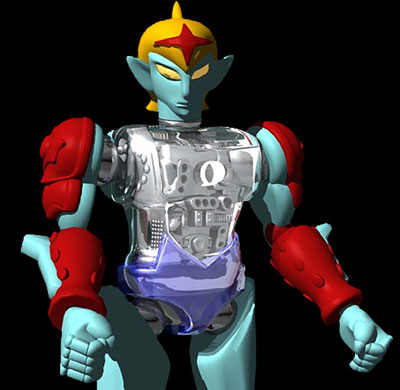
Copyright © Bryan Wilkinson. Used with permission.
Micronauts copyright © 2002 AGE, Takara, licensed to Palisades Toys.
It was great connecting with my fellow fans and collectors, doing what I could to involve them and share what we were doing. And it’s really cool and quite humbling when I see the stuff I designed on someone else’s shelf or the parts used in someone’s kitbashes and recipes, or when a figure shows up in someone else’s blog or retro-review.
It could also be very frustrating when things didn’t turn out the way intended.
In part four of the interview, MicroBry talks about the problems with the Palisades Micronauts line.
